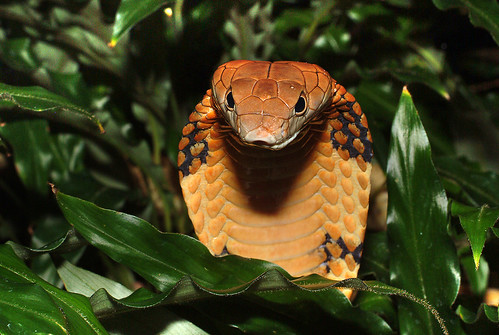The King Cobra (Ophiophagus hannah) is the world's longest venomous snake, with a length that can be as large as 6.7 m (22 ft). This species is widespread throughout Southeast Asia and parts of India, but found mostly in forested areas. Its genus name, Ophiophagus, literally means "snake-eater", and its diet primarily consists of other snakes, including sizeable pythons and even smaller members of its own species. The venom of the King Cobra is primarily neurotoxic, and the snake is fully capable of killing a human with a single bite. The mortality rate from a bite can be as high as 75%.
The King Cobra is a large and powerful snake, averaging 3.6–4 m (12–13 feet) in length and typically weighing about 6 kg (13.2 lb). A particularly large specimen was kept captive at the London Zoo and grew to 5.7 m (18.8 ft) before being euthanized upon the outbreak of World War II. The skin is either olive-green, tan, or black and it has faint, pale yellow cross bands down the length of the body. The belly is cream or pale yellow, and the scales are smooth.
The head of a mature snake can be quite massive and bulky in appearance, though like all snakes, they can expand their jaws to swallow large prey items. It has proteroglyph dentition, meaning it has two short, fixed fangs in the front of the mouth which channel venom into the prey like hypodermic needles. The male is larger and thicker than the female. The average lifespan of a King Cobra is about 20 years.


No comments:
Post a Comment